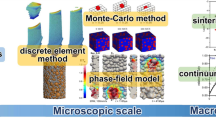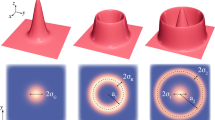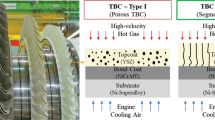Abstract
In this paper a numerical procedure is presented to calculate a laser ablation process for ceramic thick film coatings. The code is required to cover temperature dependent material data, projected beam intensities and inhomogeneous coating–substrate combinations to calculate the hole shape geometry, the temperature distribution under the surface and the ablation rate per pulse. Therefore, the ablation speed was calculated by an Arrhenius equation while the temperature distribution was simulated by means of the heat conduction equation, which is solvable by a finite differences scheme. Hence, an adaptive mesh is used and the expansion of the code to three spatial dimensions enables the simulation of more complex ablation geometries. The simulation time was held low by introducing actualization frequencies, where critical and time consuming steps were only run if necessary. A validation of the numerical simulation was done by comparing the calculated temperature depth distribution and hole geometry with micrographs of experimental ablations.













Similar content being viewed by others
References
Wenzelburger M, Lopez D, Gadow R (2006) Methods and application of residual stress analysis on thermally sprayed coatings and layer composites. Surf Coat Technol 201(5):1995–2001
Weidmann P, Weber U, Schmauder S, Martinez Garcia V (2014) Investigation of influence factors on residual stress determination within coated surfaces in consideration of the differential and integral method. Adv Mater Res 996:307–312
Lorazo P, Lewis LJ, Meunier M (2006) Thermodynamic pathways to melting, ablation, and solidification in absorbing solids under pulsed laser irradiation. Phys Rev 73(134108):1–22
Ruf A (2004) Laser in der Materialbearbeitung. Herbert Utz Verlag München
Modest MF (2006) Effects of multiple reflections on hole formation during short-pulsed laser drilling. J Heat Transf 128:653–661
Eichler J, Eichler HJ (2010) Laser Bauformen, Strahlführung. Anwendungen. Springer, New York
Callies G (1999) Modellierung von qualitats- und effektivitätsbestimmenden Mechanismen beim Laserabtragen. PhD thesis, Univeristät Stuttgart
Araya G, Gutierrez G (2006) Analytical solution for a transient, three-dimensional temperature distribution due to a moving laser beam. Int J Heat Mass Transf 49(21–22):4124–4131
Ho CY, Lu JK (2003) A closed form solution for laser drilling of silicon nitride and alumina ceramics. J Mater Process Technol 140(1–3):260–263
Roy S, Modest MF, Bang SY (1993) Cw laser machining of hard ceramics. Int J Heat Mass Transf 36(14):3515–3540
Modest MF (1996) Three-dimensional, transient model for laser machining of ablating/decomposing materials. Int J Heat Mass Transf 39(2):221–234
Tannehill JC, Anderson DA, Pletcher RH (1997) Computational fluid mechanics and heat transfer. Taylor & Francis, Washingto
Anisimov SI, Lukyanchuk BS (2002) Selected problems of laser ablation theory. Phys Usp 45(3):293–324
Carslaw HS, Jaeger JC (1959) Conduction of heat in solids. Oxford University Press, Oxford
Dubey AK, Yadava V (2008) Laser beam machining—a review. Int J Mach Tools Manuf 48(6):609–628
Kabelac S, Kind M, Martin H, Mewes D, Schaber K, Stephan P (2006) VDI-Wärmeatlas. Springer, New York
Schwarz T (1996) Beitrag zur Eigenspannungsermittlung an isotropen, anisotropen sowie inhomogen, schichtweise aufgebauten Werkstoffen mittels Bohrlochmethode und Ringkernverfahren. PhD thesis, Univeristät Stuttgart
Ajovalasit A, Petrucci G, Zuccarello B (1996) Determination of nonuniform residual stresses using the ring-core method. Trans ASME 118:224–228
Acknowledgments
This work was supported by the German Research Foundation (Deutsche Forschungs Gemeinschaft, DFG) under Grant Nos. Schm 746/120 and OS 111/37.
Author information
Authors and Affiliations
Corresponding author
Rights and permissions
About this article
Cite this article
Weidmann, P., Weber, U., Schmauder, S. et al. Numerical calculation of temperature and surface topology during a laser ablation process for ceramic coatings. Meccanica 51, 279–289 (2016). https://doi.org/10.1007/s11012-015-0220-2
Received:
Accepted:
Published:
Issue Date:
DOI: https://doi.org/10.1007/s11012-015-0220-2




